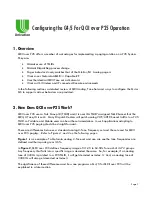
Page 4
3.
What Steps are Required in Preparation for Implementing QCII Over
P25?
In preparation for implementing the QCII Over P25 paging solution the following must be taken into
consideration.
a.
Does your system use Motorola AMBE++ capable Base Stations?
The G4/5 solution makes use of the Motorola QCII Tone Set and testing on Motorola AMBE++
capable Base Stations allows for a high degree of reliably decoding the QCII tone. The P25
System Administrator or Group responsible for the maintenance of the Dispatch Center and RF
Base Stations can assist with this information.
b.
Do you have an assigned TGID over which the QCII Tones are transmitted over?
This can be a dedicated TGID used just for Dispatched paging messages or it can be a currently
used TGID over which the QCII tones are to be transmitted over. Take into consideration, if there
is too much traffic on a currently used TGID it may delay the sending of a QCII page.
c.
What 2-Tone Coding Plan is going to be used?
The answer to the above question depends on if current analog 2-Tone VHF/UHF traffic is going
to “patched” over P25 or
if a new coding plan is to be developed.
If the plan is for current analog 2-Tones to be used to page a G4/5 pager then as mentioned
ea
rlier, care must be taken in the assignments to ensure there is a “one to one” relationship.
i.
Review existing 2-Tone coding plan
ii.
Match 2-Tone IDs with the QCII Tone Index Ranges
iii.
There may be existing 2-Tone IDs that will not have a unique QCII ID
iv.
Options are:
1.
Change a 2-Tone ID
2.
Create a new one for QCII
Figure 3 below shows an example where a current 2-Tone Plan has a conflict. There are two 2-
Tone IDs (CCII Code 9460 and 9960) whose Tone B frequencies fall into QCII Index 3 (refer to
Figure 2) so the G4/5 would treat these as the same page and not two different ones.
Figure 3:
Содержание G4
Страница 2: ...Page 2 Figure 1...
Страница 3: ...Page 3 Figure 2...
Страница 7: ...Page 7 Figure 7 Figure 8...
Страница 12: ...Page 12 Figure 1A Figure 2A...
Страница 13: ...Page 13 Figure 3A Figure 4A...
















